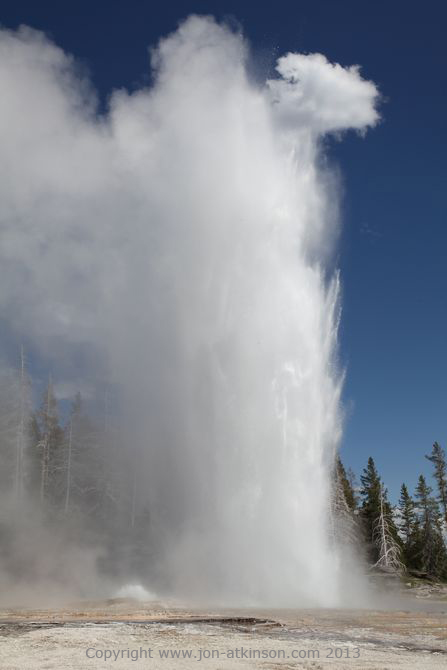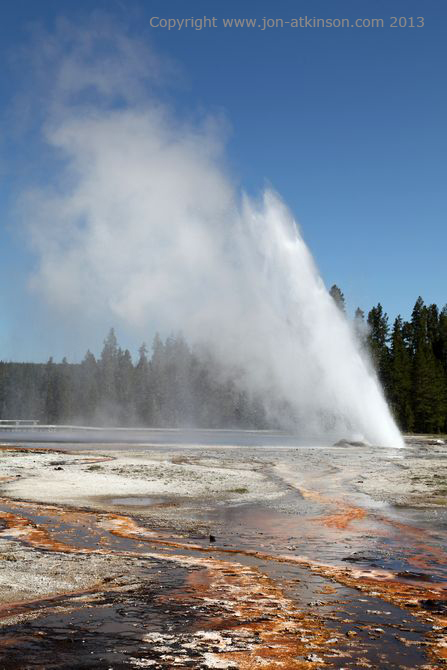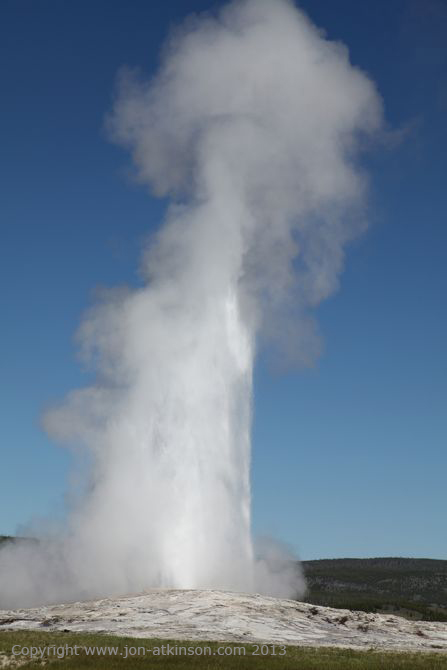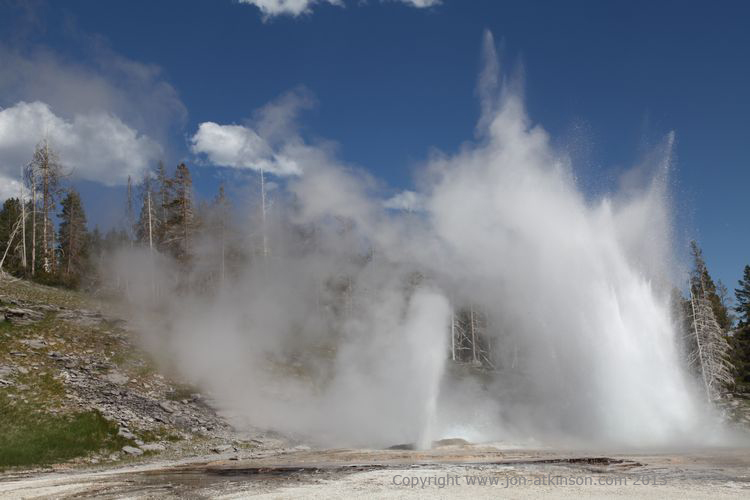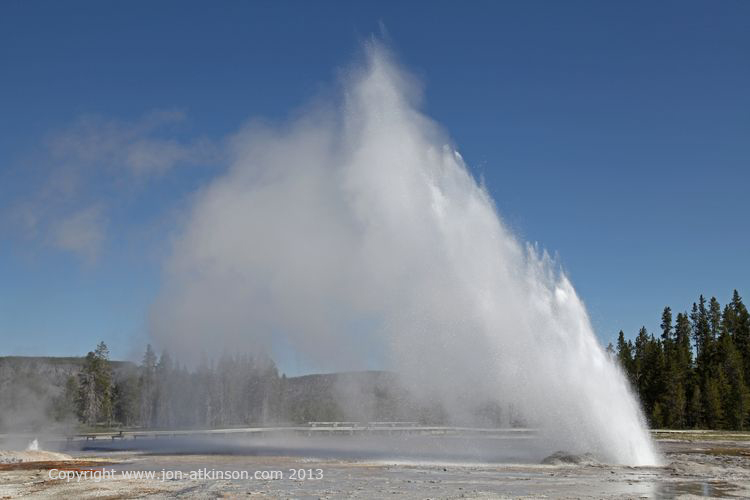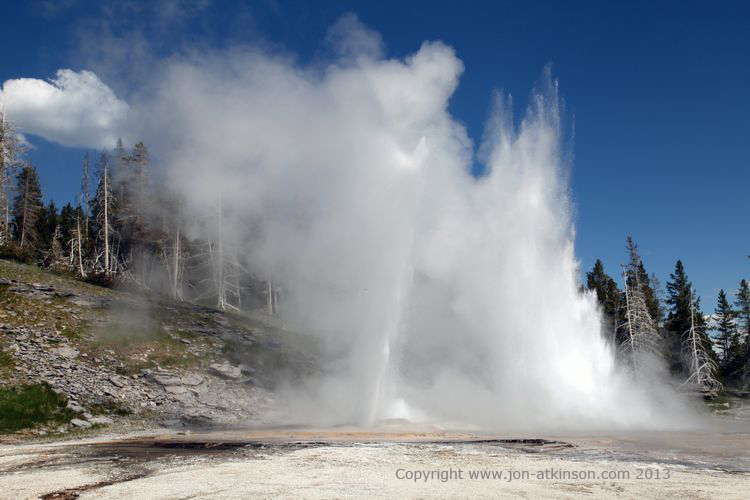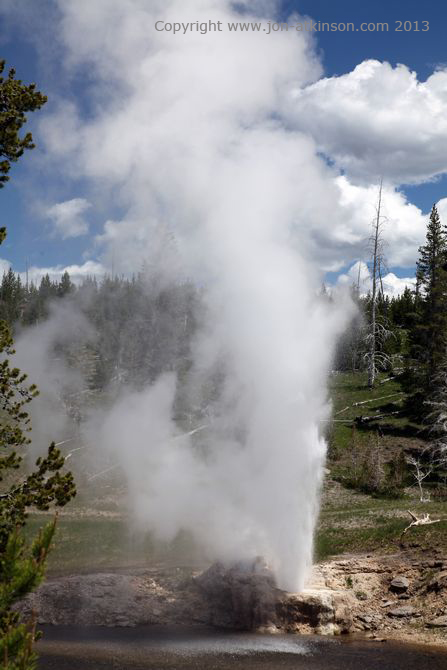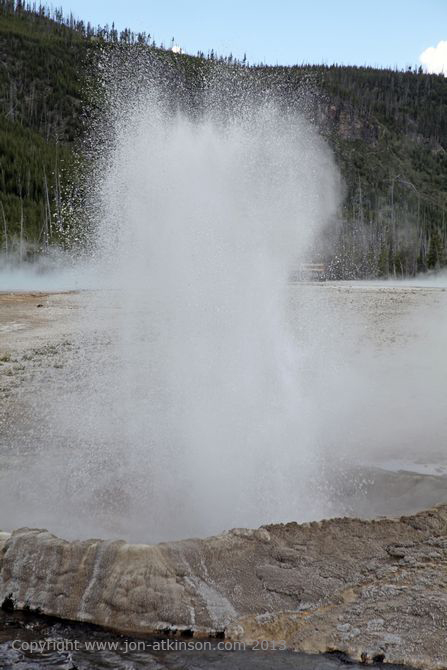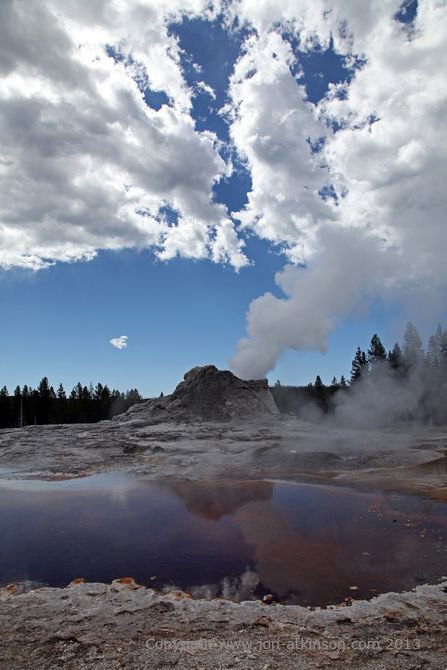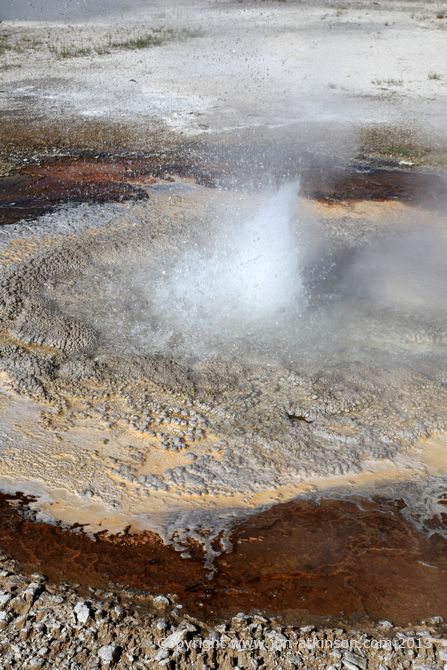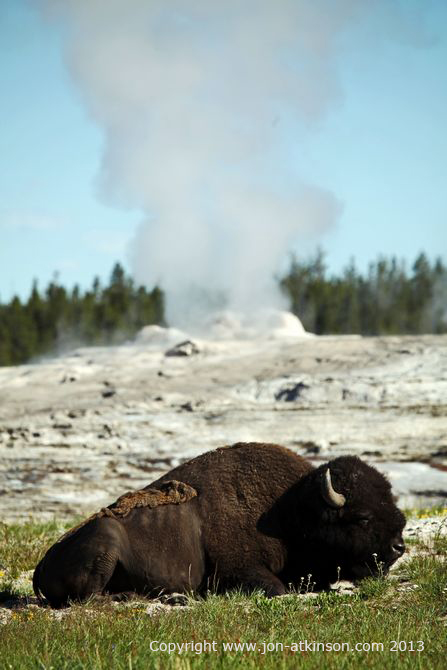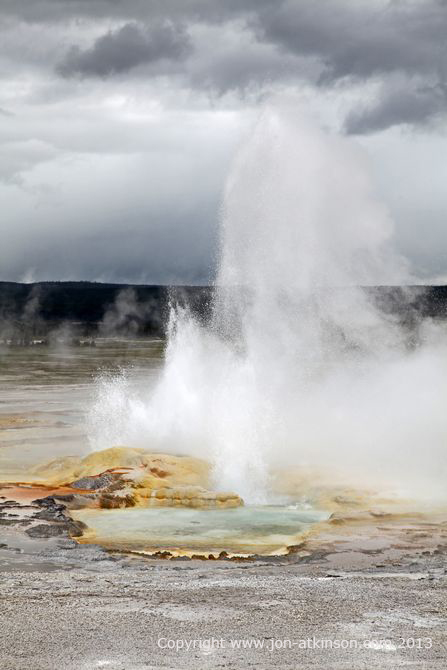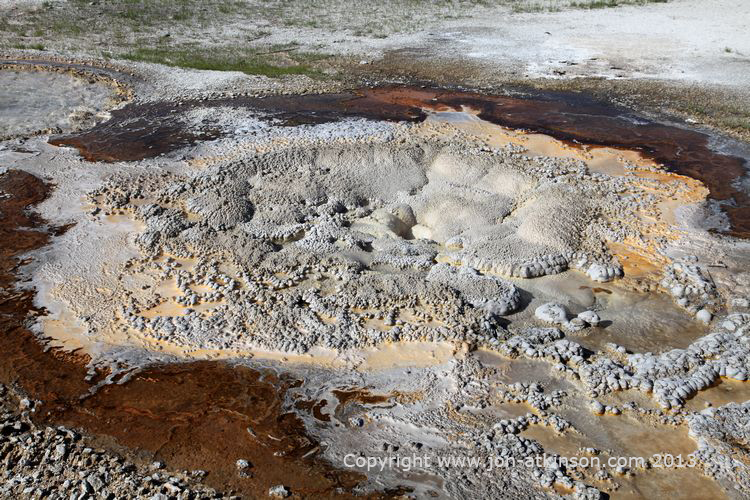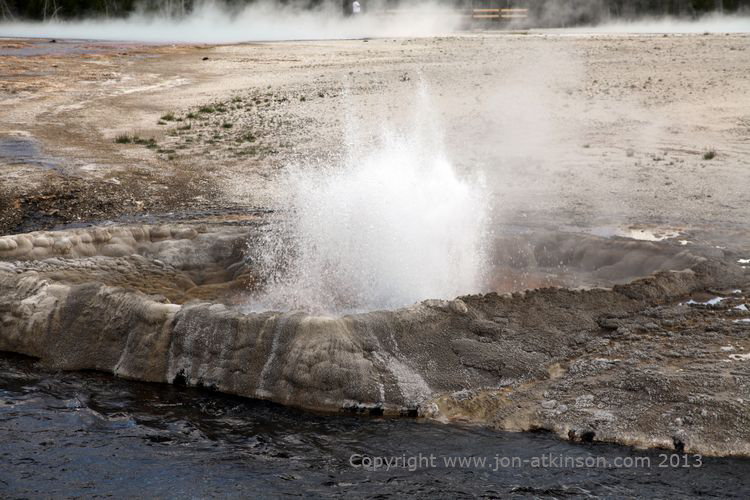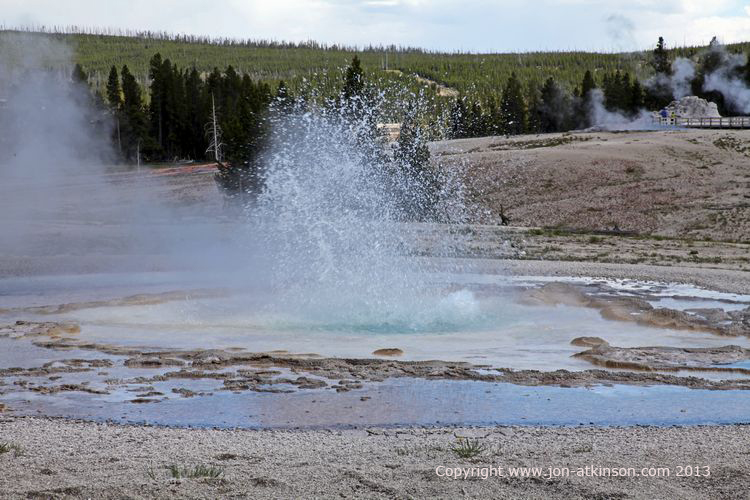YG1 - Grand Geyser, Yellowstone National Park: The Grand Geyser, which erupts every 7 to 15 hours, belongs to the Grand Group (or Grand Geyser Complex), and its eruption is connected to those of the other geysers in the group, especially the adjacent Vent Geyser and Turban Geyser. |
YG2 -Daisy Geyser, Yellowstone National Park: Daisy Geyser is part of the Daisy Group. It was named prior to 1890 by the Hague Party. It erupts every 110 to 240 minutes for a period of 3 to 5 minutes and is one of the most predictable geysers in the park. Its fountain erupts at an angle to the ground and reaches a height of 75 feet (23 m). |
YG3 - Old Faithful, Yellowstone National Park: Old Faithful was named by the first official expedition to Yellowstone, the Washburn Expedition of 1870. They were impressed by its size and frequency. The eruption heights vary from 106 feet to 184 feet, with an average of 130 feet, and discharges of up to 8,400 gallons of water per eruption. |
YG4 - Grand Geyser, Yellowstone National Park: Grand's fountain reaches a height of as much as 200 feet (61 m), with a duration of 9 to 12 minutes. Its eruptions normally occur in a series of 1 to 4 bursts. The forecasted window of opportunity for an eruption of Grand Geyser is four hours which means that patience is required.
| YG5 - Daisy Geyser, Yellowstone National Park: An eruption of Daisy Geyser starts with boiling water splashing from one of several vents in the thick sinter ledge partially surrounding the geyser’s crater. This eruption indicator means that a full eruption is about to occur. Boiling water soon pours over the crater’s edge, and the splashing increases until the eruption starts. |
YG6 - Grand Geyser, Yellowstone National Park: When the Grand Geyser’s pool is full it has a sort of built-in timing mechanism in its neighbor, Turban Geyser. Turban Geyser erupts about every 20 minutes, and Grand is most likely to erupt right about the time that Turban is set to erupt.
|
YG7 - Riverside Geyser, Yellowstone National Park: The geyser is located on the Firehole River within the Upper Geyser Basin. The geyser shoots steam and water to heights of 75 feet (23 m) in an arch over the river. The eruptions occur every 51/2 to 7 hours.Riverside is one of the most predictable geysers in the park because it is not located near any other geysers that may disrupt the flow of underground water in the geyser's plumbing. |
YG8 - Cliff Geyser, Yellowstone National Park: A. C. Peale, geologist for the 1872 Hayden Expedition, named this feature for its cliff-like wall of geyserite formed around the crater and for its location on the edge of Iron Creek. When it is active there are usually one or two eruptions a day. An indication of a pending eruption is that the crater nearly fills with boiling water. |
YG9 - Castle Geyser, Yellowstone National Park: Castle Geyser is a cone geyser in the Upper Geyser Basin. It is noted for the large geyserite sinter deposits, which form its cone. These deposits have been likened in appearance to a castle. It has a 10 to 12 hour eruption cycle. The geyser erupts hot water for about 20 minutes in a vertical column that reaches a height of 90 feet (27 m) before changing to a noisy steam phase that issues for 30 to 40 minutes. |
YG10 - Anemone Geyser, Yellowstone National Park: The Anemone Geyser is actually two related geyers in the Upper Geyser Basin of Yellowstone National Park, The larger of the two is known as Big or North Anemone while the smaller is known as Little or South Anemone. The two geysers were named after the anemone flower by the Hague Party in 1904. |
YG11 - Old Faithful, Yellowstone National Park:Old Faithful is one of the most predictable geysers in all of Yellowstone Park. Its heights, intervals and lengths of eruption are constantly changing and evolving due to ongoing processes within its 'plumbing' and from earthquakes. It has two types of eruption patterns - short ones that last 1 1/2 to 2 minutes, and long ones that last 3 to 5 minutes. |
YG12 - Clepsydra Gesyer, Yellowstone National Park: Clepysdra Geyser erupts continuously to heights of 45 feet (14 m). It only seems to take a break when its neighbors are erupting. It was named by T. B. Comstock during the 1878 Captain Jones expedition the name being derived from the Greek word for water clock. |
YG13 - Anemone Geyser, Yellowstone National Park: Big Anemone has eruptions lasting 25 to 45 seconds every 6 to 10 minutes reaching a height of 6 to 8 feet (1.8 to 2.4 m). Little Anemone has less vigorous but longer lasting eruptions than Big Anemone. The interval between eruptions can vary from 6 to 35 minutes, and eruptions can last from less than a minute to more than 30 minutes. The fountain rarely reaches more than 4 feet (1.2 m) in height and on occasion, the crater will fill with water then drain without erupting. |
YG14 - Cliff Geyser, Yellowstone National Park: As the eruption begins, jets of water explode through the pool 15 to 40 feet high. This is accompanied by a tremendous amount of steam. The eruption reaches its highest point the first half hour and gradually subsides until the crater empties. The interval is irregular, lasting between a half hour to 18 hours, and there may be weeks or even years of dormancy. |
YG15 - Sawmill Geyser, Yellowstone National Park: Sawmill Geyser, named for the whirring sound it makes during its eruption was named by Antoine Schoenborn of the Hayden Geological Survey of 1871. This geyser has an irregular pattern of eruption due to the structure underground plumbing of the geysers, but has a delay around 1 to 3 hours between eruptions which reach heights of 35 feet (11 meters). |

